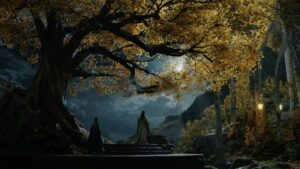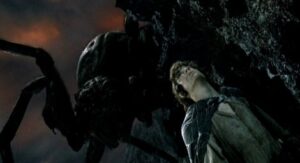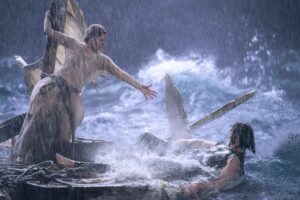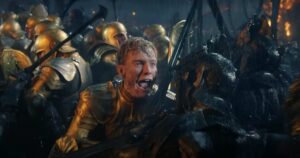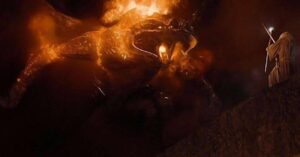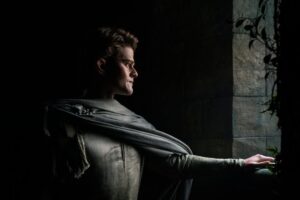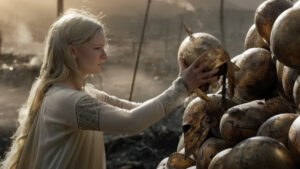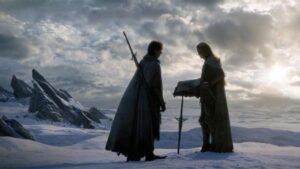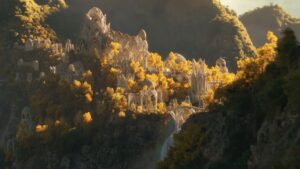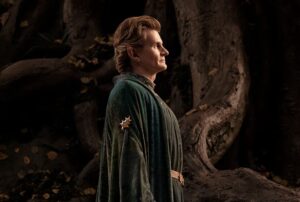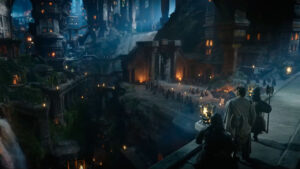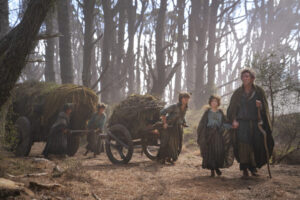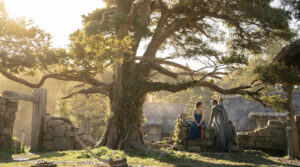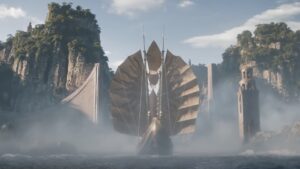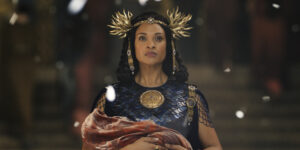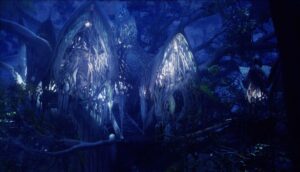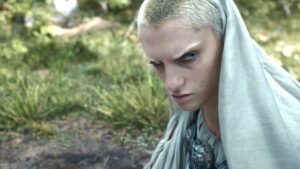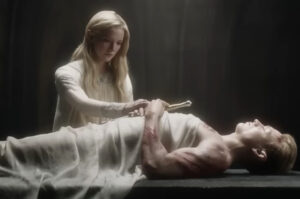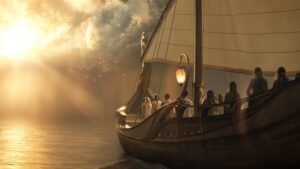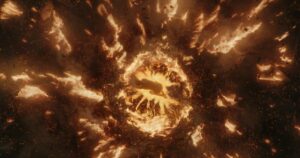MINOR SPOILERS FOR THE RINGS OF POWER EPISODE ONE!
“Among those of [Morgoth’s] servants that have names the greatest was that spirit whom the Eldar called Sauron..,.in all the deeds of Melkor the Morgoth upon Arda, in his vast works and in the deceits of his cunning, Sauron had a part, and was only less evil than his master in that for long he served another and not himself. But in after years he rose like a shadow of Morgoth and a ghost of his malice, and walked behind him on the same ruinous path down into the Void.”
– The Silmarillion: Valaquenta, p. 23
Although Amazon was denied access to the contents of The Silmarillion (and it’s evident from the opening scene just to what extent this has hindered their ability to tell a coherent story), The Lord Of The Rings: The Rings Of Power is best described as a Silmarillion sequel of similarly gargantuan proportions, and not as a prequel to The Lord Of The Rings, despite how Amazon and the mainstream media have jointly marketed the series, and what its long and unwieldy full title would perhaps lead you to believe…and I mean that not merely in the sense that The Rings Of Power picks up right where The Silmarillion left off, with the great enemy Morgoth defeated and his lieutenant Sauron still evading capture in Middle-earth, but in that the writers have constructed an original story around these events that feels almost too large for even this largest and most expensive of television series’ – a grand and somber narrative spanning centuries, with a massive ensemble cast given precious few moments to leave a lasting impression in these first two episodes.

Yet on that note, there are hundreds upon hundreds of named characters in The Silmarillion, many of whom only stick around for a couple of pages and some of whom are mentioned just once or twice in a single paragraph, and these characters have nonetheless made an impression on people – so I firmly believe that the protagonists of Amazon’s epic series will do the same, especially seeing as the main cast already have more screentime in just two episodes than most of The Silmarillion‘s main characters had in a whole book. Still not as much as they deserve, mind you, but just enough that you’ll know going into episode three which of these characters you’ll want to spend more time with – and I can say without a shadow of a doubt that, for me, those characters are Elanor Brandyfoot (Markella Kavenagh), Elrond (Robert Aramayo), and Disa (Sophia Nomvete), the latter of whom I’ll speak about in my review of episode two.
Collectively, these three characters represent almost all the Free Peoples of Middle-earth – Harfoots, Elves, and Dwarves, respectively – and at this point I’m just waiting for a charismatic human character to come along and give me a reason to get invested in the dealings of Men. Nazanin Boniadi does her level best with the character of Bronwyn, a shy and unassuming single mother from the Southlands who falls in love with a Silvan Elf, but humans in The Rings Of Power are the most underwritten of all the races that make up Middle-earth’s diverse population. To some extent, that could be interpreted as a reflection of their current social status in Middle-earth and an unconscious bias on the part of our Elven protagonists and narrator, but I have a feeling it’s probably not intentional.
Nonetheless, with so many different peoples represented in just the first two episodes, even if only briefly, the scope of this series is quite large – as I said, almost too large. In episode one, following a necessarily vague and therefore somewhat unhelpful prologue that is memorable mostly for the fact that it’s the first time we’ve seen events from The Silmarillion adapted for the screen, we flash-forward to find our main characters scattered far and wide across Middle-earth, each isolated to their own little corner of the map where they can pursue their own agendas untroubled. And while I’m hardly the first person to say this, it bears repeating that each location we visit is distinct and extraordinarily beautiful, from the rolling hills of Valinor bathed in unearthly light to the cliffs of Lindon overlooking the young sea, and the tumbling ladders of crystalline ice suspended from mountaintops in the Forodwaith.
In fact, not to get side-tracked or anything, but I can’t overstate it enough that The Rings Of Power is beautiful; genuinely some of the most beautiful television ever produced. Director J.A. Bayona definitely got the memo that Middle-earth is as much a character in Tolkien’s stories as any Elf or Hobbit, and just as deserving of flattering close-ups every now and again. If there’s one fault with Bayona’s direction, it’s that whenever his camera comes to rest just over a character’s shoulder during a reverse-angle dialogue sequence, he has a tendency to leave it there for the duration of the scene, which grows especially frustrating when the environments in which these characters are placed are clearly practical sets demanding – nay, pleading – to be interacted with and walked upon! I’m not feeling the energy that these sets inspired in the actors, and which they could have used to their advantage if they were allowed to ever move about.
Anyway, forgive me my occasional tangents. We’re first introduced to the Elves – an immortal race of beings from beyond the Sundering Seas who reside in Middle-earth partly out of genuine love for the land, and partly because the land was bought with their own blood. Characters like Elrond, who are relatively young in Elven years, have a vision of what Middle-earth could be if the Elves finally laid down their weapons and allowed themselves to be at peace for once in their lives, while Galadriel (Morfydd Clark) is still poking around in dark corners, searching for any sign of Sauron, the undefeated enemy responsible for so much of her sorrow.
Conceptually, Galadriel’s arc is quite the compelling one – and the idea that there are Elves who wish for her to stop, and would even conspire with each other to send her packing and put an end to the war she insists on prolonging for her own purposes, is all rather fascinating. In execution, it only works half the time. Legally, The Rings Of Power can’t plumb the depths of Galadriel’s trauma without encroaching upon territory covered exclusively in The Silmarillion, including the gruesome details of her elder brother Finrod (Will Fletcher)’s death at the hands of Sauron. We only spend a few moments with Finrod in waking life before he’s dead, suddenly, at which point Galadriel embarks on her quest for vengeance.
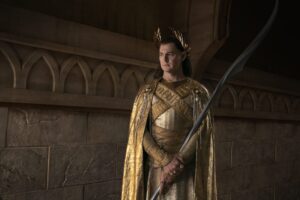
Galadriel has been hunting Sauron for centuries by the time we catch up with her in the Northern Wastes, and is still hot on his heels, but we as the audience are only allowed one quick glimpse of the Dark Lord (conveniently wearing a familiar suit of full-body armor) – and while we can all agree that he looks absolutely fantastic, I can’t help but wonder if one shot is enough to convince fans, particularly casual fans who aren’t aware of the atrocities Sauron committed while serving under Morgoth, just what a threat he poses to Middle-earth. Sure, poisoned cow’s milk in Tirharad and decayed mallorn leaves in Lindon are an indication that he’s probably up to no good, but until orcs start popping up in the Southlands in episode two, the only tangible antagonist is a single hungry snow-troll that stupidly attempts to ambush Galadriel in a cave.
Still, one could argue that the Elves are the antagonists of their own story – for indeed, it’s their pride, their stubbornness, and their misplaced confidence in their own might that leads the High King of the Noldor, Gil-galad (Benjamin Walker), to dismiss all of the evidence piling up as just a string of coincidences out of which Galadriel has constructed a false narrative that Sauron has returned. In that sense, too, The Rings Of Power is much like The Silmarillion: for at their core they are both stories of Elven failings. Where the stories may differ slightly, and where The Rings Of Power certainly differs from previous adaptations of Tolkien’s work, is that The Rings Of Power doesn’t depict the Elves as ethereal or untouchable to the point where their aloof attitude is ever justified.
Nor are they capable of the same gravity-defying feats that Peter Jackson’s Elves effortlessly pulled off in The Hobbit trilogy. In fact, physically, they’re almost indistinguishable from humans. Some might consider this a downgrade – personally, I find it to be an intriguing stylistic choice that unexpectedly serves a thematic purpose in the story. For if Elves look just like humans, and they act just like humans, then the only thing differentiating them from humans is their immortality – and for a human, to look at an Elf and see nothing there so vastly different from themselves that it could be said to warrant the gift of immortal life being bestowed to one and not the other, that would be weird and a little conflicting. On top of that, the Elves and humans are still pretty close in the Second Age, so these are people the humans know well, and regard as friends, if not nearly family.
Well, mostly. In Middle-earth’s Southlands, where Elves were assigned to watch over the descendants of humans who followed Morgoth during the First Age, there’s a clear divide between the two peoples that is widening with each passing day – and only Bronwyn and a Silvan Elf named Arondir (Ismael Cruz Córdova) have any interest in bridging that divide. While their relationship is described in romantic terms by supporting characters in-universe (Arondir is harshly reminded by his Elven compatriots that two prior unions between Elves and Men ended tragically), I have not yet discerned this apparently palpable chemistry of which they speak. It’s only when the two characters find themselves suddenly standing on the front lines of the war for Middle-earth that I was even convinced they cared for each other.
Still, while neither Arondir nor Bronwyn is particularly high on my list of characters I cared about deeply after watching the first two episodes, I’m nonetheless curious about life in the Southlands for both the Silvan Elves and the descendants of Morgoth’s worshippers, and I wish The Rings Of Power used its time as wisely as it did its enormous budget; perhaps then we could have explored the conflict between Elves and Men with some proper nuance and avoided awkward moments…like when a kid refers to Arondir by the name “Knife-Ears” (I need writers to stop inventing fantasy slurs, please for the love of Eru, stop), or when Arondir tells Bronwyn that the residents of a nearby village were especially loyal to Morgoth in the old days, as if it hasn’t been over a thousand years since then – you’re telling me that the people of these two neighboring villages didn’t intermingle and intermarry to the point where such labels would be meaningless after a few generations?
I suppose it’s not so bizarre that an Elf would think that way, but that one line – well, that and Bronwyn’s immediate rebuttal that the people in the village are “good people”, close kin of hers – doesn’t make for the most thorough exploration of the subject. And unfortunately, Bronwyn is interrupted before she can say anything more, when she and Arondir find the village in question deserted. That’s the end of that conversation, and as of episode two the writers have not yet picked up this story-thread again.
That sort of thing happens a lot in the first two episodes of The Rings Of Power (not that specific scenario, just scenes being interrupted before they can reach their seemingly natural conclusion), which is why I take issue with complaints that the pacing is slow. I felt as though the first episode raced by! The moments that stand out to me in these episodes, generally, are the still and contemplative moments that have been given space to breathe – when the show isn’t rushing on to the next thing but instead allowing us to live in the present with characters we adore, set amidst beautiful scenery or on any of those magnificent practical sets I mentioned before. I think that’s one reason why both Elrond and Elanor got through to me, because they’re the two characters who benefit most from such moments in the first episode.
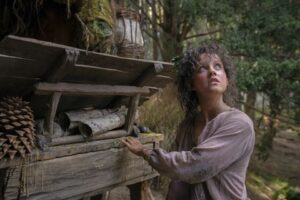
The time we spend with the Harfoots in episode one, for example, is time well-spent establishing characters and character dynamics that will be easy to remember going forward. Elanor Brandyfoot is an inquisitive young Harfoot who wants to see the great wide world off the beaten path that the Harfoots take each year as they migrate back-and-forth across the same familiar patch of land in Rhovanion (a patch of land that by the time of The Lord Of The Rings had become an “unfriendly waste”, blasted by some “pestilence or war or evil deed of the Enemy” – so make a mental note of that). Her best friend, Poppy Proudfellow (Megan Richards), is the prehistoric Samwise Gamgee to her prehistoric Frodo Baggins; well, perhaps not quite as fascinated by Elves as Sam would be, but no less willing to help her friend out of a tight situation at a moment’s notice.
Even outside of these two characters, I felt that we really got to know the Harfoots, individually and collectively, who they are and what they stand for, as they spend the entire first episode preparing for a festival to mark the end of summer (who wants to bet it’s held on September 22nd?), while avoiding “Big People” and other dangerous creatures wandering across their lands. There are several character actors with small but memorable roles sprinkled amongst the Harfoots, including legendary British comedian Sir Lenny Henry as an elderly sage named Sadoc Burrows who is in possession of the Harfoots’ only book – and is the only Harfoot capable of reading it. Thusitha Jayasundera is also delightful as Malva, a gossip constantly prophesying doom who hangs around Sadoc in the hopes that he’ll spill some secrets from his dusty old book.
Because it’s not until the very end of episode one that something momentous actually happens to the Harfoots in the form of an old man falling from the sky (more on him in my review of episode two), the Harfoots are, for the time being, relatively inconsequential in the grand scheme of things. As Elanor’s mother Marigold (Sara Zwangobani) tries to explain to her, the Harfoots don’t need to get involved in Big People business because they have each other, they always have and they always will, and that’s always been enough. Therefore, while it comes as no surprise that the Harfoots are easily the most endearing characters in The Rings Of Power, I was personally shocked to discover that their subplot is also one of the most interesting, even before the arrival of the aforementioned Stranger (Daniel Weyman).
Of course, it’s because the Harfoots make the most of their limited screentime that this is the case – and I’m sure I’d feel the same way about Elves or Men if we had spent a little more time getting to know them as actual characters – but I think part of it, at least for me, is that the Harfoots, alone of all the Free Peoples we’ve met (with the possible exception of the Dwarves, but they don’t show up until episode two), are unfamiliar in a way that is particularly immersive, because it underscores how far removed this story is from the events of The Lord Of The Rings.
To put it another way, when we first enter the Elf-kingdom of Lindon in episode one, I felt at-home right away because The Rings Of Power uses all the same design cues for the Elves and their architecture that Peter Jackson did – Lindon is, much like Jackson’s interpretation of Rivendell, a web of open-concept porticos and colonnades draped across cliffs and autumnal woodlands. It’s beautiful, don’t get me wrong, but it does make me feel as though I’m returning to Middle-earth the way that Peter Jackson conceived it, when really I want to see something different, something new (is it any wonder Elanor is my favorite character?). When we meet the Harfoots, living not yet in cozy holes in the ground but in tents and small carts in the middle of the woods, rather like the Nelwyn from 1988’s Willow…that was the moment Rings Of Power first pulled me out of my comfort-zone, and it felt wonderful.
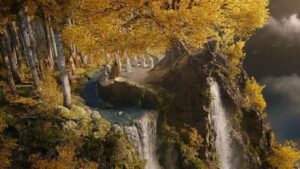
In that moment, I wasn’t returning to Middle-earth – I was being reintroduced to this world and these characters as I’ve never seen them before onscreen or even in the pages of J.R.R. Tolkien’s books. I can predict each step the Harfoots will have to take for them to transform over time into the Hobbits of the Third Age, but I’m enjoying this take on the Harfoots so much that I don’t need to see them evolve any time soon – and in just five seasons, I don’t know that The Rings Of Power could even believably get them to the point where they’d be recognizable from The Lord Of The Rings, decked out with late 19th Century accoutrements like pocket-watches, parasols, and floral-printed waistcoats with brass buttons.
That being said, The Rings Of Power covers over five-hundred years of Middle-earth’s history in a prologue under five minutes long (though there’s enough intentionally vague imagery in there that you’ll still want to check out my recent Silmarillion summary so you can pick up on easily-overlooked details) before jumping forward a few thousand years to an indeterminate point on the timeline somewhere near the end of the Second Age, so it’s clear now that the writers are taking many liberties with the chronology where they feel it suits their story to have, say, Celebrimbor (Charles Edwards) alive simultaneously to the last Númenóreans.
I can’t honestly say that it bothers me every time the Tale of Years has been slightly altered, but I do find it strange that the character dynamics amongst the Elves don’t at all reflect their canonical age differences – Elrond and Galadriel, for instance, speak to each other as if they’re roughly the same age, when in truth Galadriel is anywhere between 5000 to 24000 years old in The Rings Of The Power, while Elrond, at a mere 1500 years old, is young enough to be her future son-in-law. Gil-galad and Celebrimbor are a generation younger than Galadriel, yet both are played as if they’re much older, and portrayed by middle-aged actors to boot.
I have no desire to dissect every moment in the first episode that I would consider “lore-breaking”, because inevitably that will turn into nit-picking and in fact I’m quite satisfied with how The Rings Of Power has turned out, so if that’s the kind of coverage you’re expecting I urge you to continue your search elsewhere besides my blog. Just to give you a sense of what kind of thing irritated me, and because I think it will irritate me for a long time yet and I need to share this burden with my readers, I was…deeply conflicted when Gil-galad granted Galadriel permission to return across the Sundering Seas to Valinor, as if he possessed the authority to do so. On the one hand, I understand that it would be exceedingly difficult to explain why Galadriel is banned from heading west without mentioning her crimes against the Valar in the First Age that Amazon can’t legally mention, but also…it just felt so wrong.
On a more positive note, while I expected to be extremely critical of the original dialogue written for The Rings Of Power, I can only think of a few instances from the first episode where a line was poorly-written or its delivery fell flat. For the most part, Amazon’s writers did an admirable job of mimicking Tolkien’s signature style without ever reusing or misappropriating lines from The Lord Of The Rings. But given how high the bar is that they’ve set for themselves, every occasion on which they fail to clear that bar – in the first episode, the worst line of dialogue is undoubtedly “Elf-lords only” – will momentarily break the immersion.
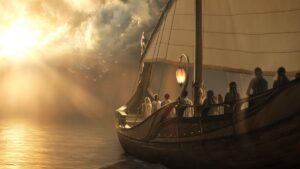
What will draw you back in again, whether you’re a diehard fan or someone just looking for a cool new show to watch over the weekend, are the characters (whom you really can’t help but root for), and the visual splendor on display in every frame of these first two episodes. After finishing these episodes, you may feel – as I do – that the story still needs a little more time to solidify into the firm backbone required of a multi-season series and a potential billion-dollar investment on Amazon’s part, but if Amazon (and audiences) are willing to give The Rings Of Power the time it needs to do just that, it could quickly grow to become what it already aspires to be: a worthy sequel to The Silmarillion.
Episode Rating: 7.5/10

